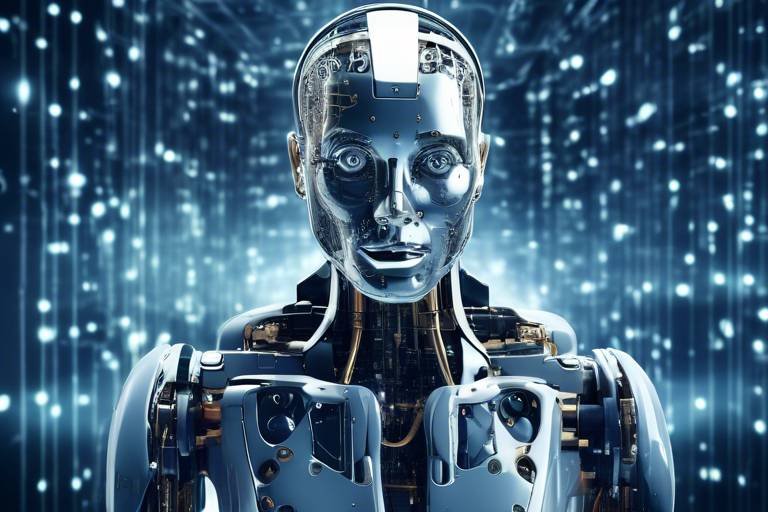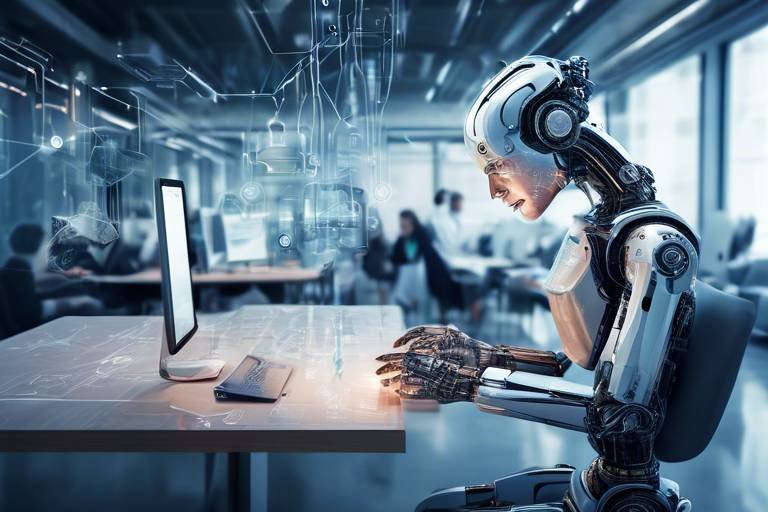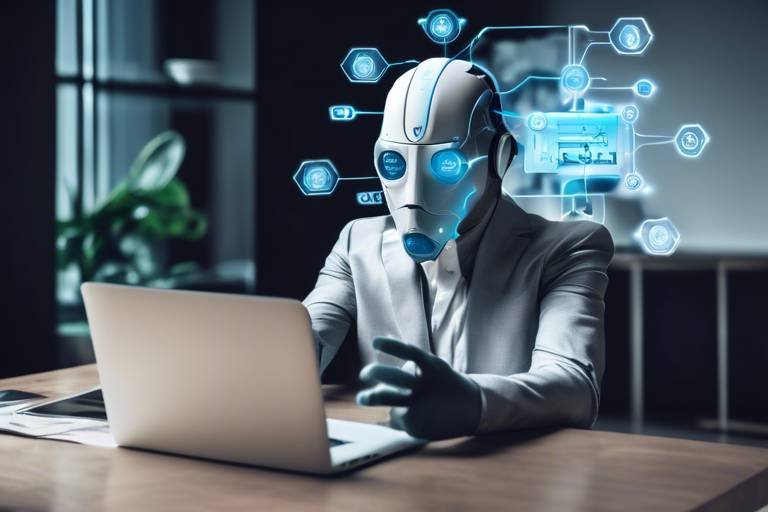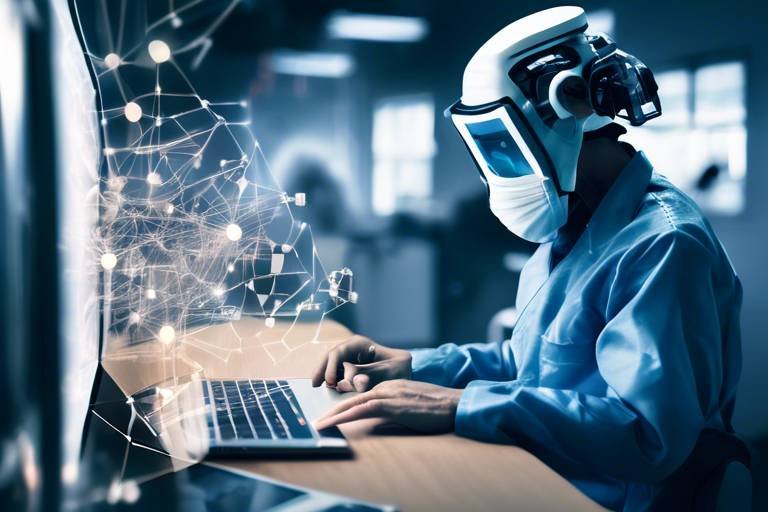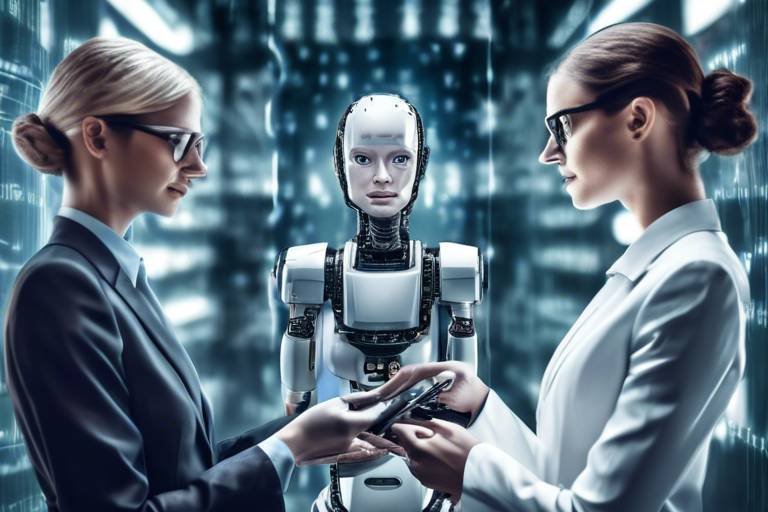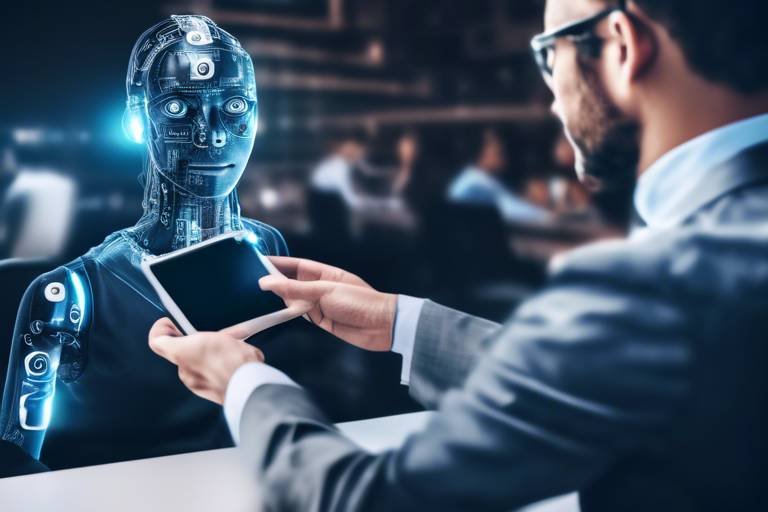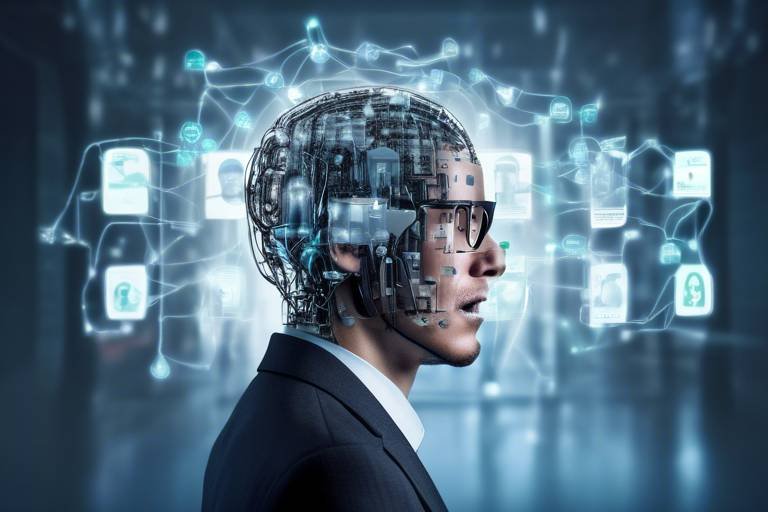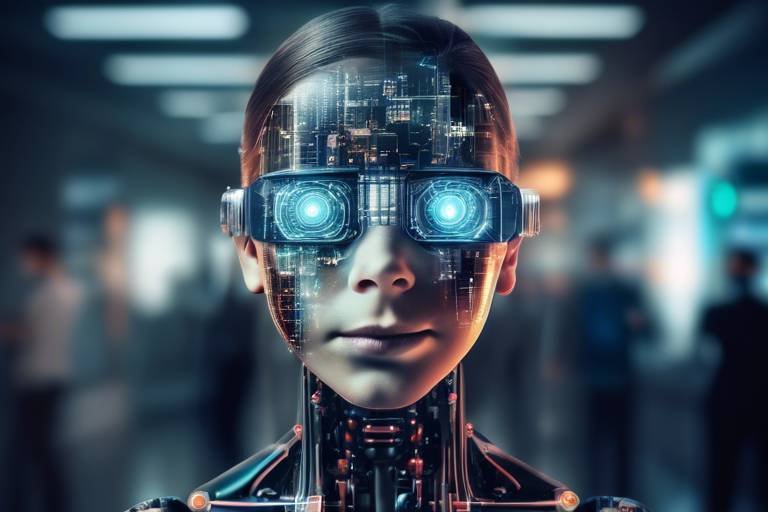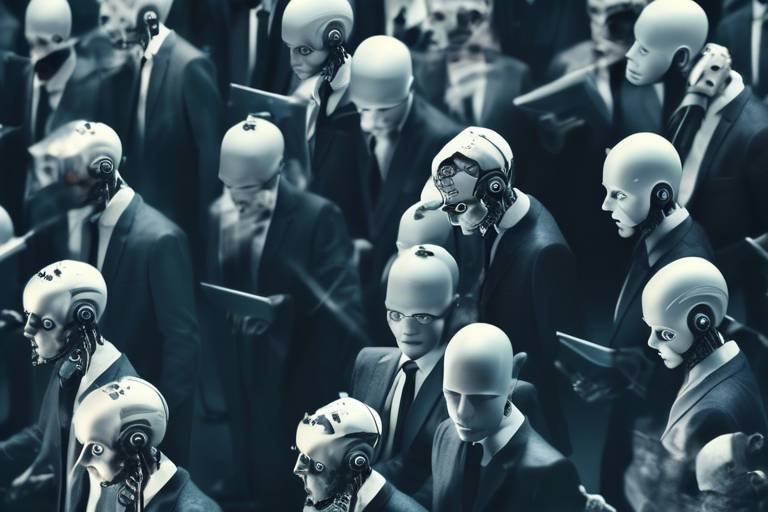AI and Employee Rights: A Future Outlook
In today's rapidly evolving technological landscape, the intersection of artificial intelligence (AI) and employee rights is becoming increasingly significant. As we navigate through this new era, it's essential to understand how AI is not just a tool for efficiency but also a game changer for workplace dynamics. What does this mean for the rights of employees? Are we on the brink of a revolution that could redefine our work environments, or are we stepping into a realm of uncertainty? This article will delve into the multifaceted impacts of AI on employee rights, exploring challenges and future considerations that workers may face in an increasingly automated workplace.
AI is reshaping the workplace in profound ways. From automating mundane tasks to enhancing overall productivity, the integration of AI into daily operations is not just a trend; it’s a transformation. Imagine a world where machines handle repetitive tasks, allowing employees to focus on more creative and strategic initiatives. However, this transformation raises crucial questions: How will job roles evolve? What responsibilities do employees have in adapting to these changes? Understanding the role of AI in the workplace is vital for assessing its impact on employee rights and responsibilities. As we embrace these innovations, we must also consider how they affect the very fabric of our work culture.
As AI technology advances, current laws surrounding employment and technology must evolve. The legal landscape is often slow to adapt, creating gaps in protection for employee rights. For instance, existing labor laws may not adequately address the complexities introduced by AI systems. Analyzing these legal frameworks helps identify challenges that employees may face in an AI-driven environment. Are our laws robust enough to protect workers from potential abuses? What changes are necessary to ensure that employee rights are upheld in this new reality?
AI systems thrive on data, and often, this data is personal. As businesses increasingly rely on AI, the implications of data privacy laws become more critical. Employees have a right to know how their data is being used, and the intersection of data privacy and employee rights is a pressing concern. Are organizations transparent about their data practices? This section will discuss the importance of data privacy laws and their implications for employees in the workplace.
Ensuring that employees are informed about data usage is essential. Without proper consent and transparency, employees may feel vulnerable and exploited. It’s crucial for organizations to foster an environment where employees understand how their data is utilized. This not only builds trust but also empowers employees. So, how can companies ensure that consent is genuinely informed? This question is at the heart of discussions surrounding AI applications affecting employee data.
One of the most alarming aspects of AI is its potential to perpetuate biases. AI systems are only as good as the data they are trained on, and if that data contains biases, the outcomes can be discriminatory. This section will explore how discrimination can arise from AI systems and the implications for employee rights and workplace equity. Are we inadvertently creating a workplace that favors some while marginalizing others? This is a critical question that needs addressing as we integrate AI into our work environments.
As AI automates tasks, concerns about job displacement become more pronounced. The potential economic impact on workers cannot be overlooked. What happens to employees whose roles are rendered obsolete by machines? This section evaluates the responsibility of employers to mitigate these effects. Are companies prepared to offer retraining and support for displaced workers? The answers to these questions could shape the future of work as we know it.
Anticipating future regulations is vital for ensuring that employee rights are protected in the age of AI. As governments and organizations grapple with the implications of AI, potential legislative changes could significantly shape the relationship between technology and workers. This section explores what those changes might look like and how they could impact employee rights moving forward. Will we see a global standard for AI regulation, or will it vary widely from one jurisdiction to another?
Different countries are approaching AI regulation in various ways, creating a patchwork of guidelines and laws. This subsection examines international perspectives and their implications for global employee rights. Are some countries leading the way in protecting employee rights, while others lag behind? Understanding these global perspectives is crucial for anticipating future trends in AI regulation.
Certain industries may require tailored regulations to address unique challenges posed by AI. This part discusses how sector-specific guidelines can better protect employees in diverse fields. For instance, the regulations for tech companies may differ significantly from those in healthcare. What are the specific needs of these industries, and how can regulations adapt to meet them?
To thrive alongside AI, employees must be empowered through education and advocacy. This section explores strategies for equipping workers with the skills and knowledge needed in an AI-enhanced workplace. Are companies doing enough to prepare their workforce for the changes ahead? The future will belong to those who are ready, and it’s crucial that employees are not left behind.
- How does AI impact employee rights? AI can affect employee rights by changing job roles, data privacy, and the potential for discrimination.
- What are the legal implications of AI in the workplace? Current legal frameworks may not adequately protect employees as AI technology evolves.
- How can employees protect their rights in an AI-driven environment? By staying informed, advocating for transparency, and seeking education on AI-related changes.

The Role of AI in the Workplace
Artificial Intelligence (AI) is not just a buzzword anymore; it’s a reality that’s reshaping how we work, interact, and even think about our jobs. Imagine walking into an office where mundane tasks are handled by intelligent systems, allowing employees to focus on more creative and strategic initiatives. This transformation is not merely about replacing human labor; it’s about enhancing productivity and redefining job roles. As AI integrates into daily operations, understanding its role becomes crucial for assessing its impact on employee rights and responsibilities.
One of the most significant ways AI is influencing the workplace is through automation. Tasks that once required human intervention, such as data entry, scheduling, and even customer service, are increasingly being handled by AI systems. This automation is not only speeding up processes but also reducing the likelihood of human error. For instance, AI-driven chatbots can manage customer inquiries 24/7, providing immediate responses and freeing up human employees to tackle more complex issues. However, this leads us to a pivotal question: what happens to the employees in roles that are being automated?
AI is also enhancing productivity by providing tools that help employees perform their jobs more efficiently. For example, AI algorithms can analyze vast amounts of data to generate insights that inform decision-making. This capability allows employees to make data-driven choices rather than relying solely on intuition. Furthermore, AI can assist in project management by predicting potential bottlenecks and suggesting solutions, thereby streamlining workflows. However, while these advancements can lead to increased efficiency, they also raise concerns about employee autonomy and the potential for over-reliance on technology.
As AI continues to reshape job roles, it’s essential to recognize that not all changes are negative. In fact, many new roles are emerging as a result of AI implementation. For instance, positions in AI ethics, data analysis, and machine learning engineering are becoming increasingly vital. These roles require a blend of technical skills and ethical considerations, emphasizing the need for ongoing education and training. Companies that invest in their employees’ upskilling will not only foster loyalty but also ensure that their workforce is equipped to thrive in an AI-enhanced environment.
However, the integration of AI into the workplace does not come without its challenges. The shift towards automation can lead to job displacement, leaving some workers feeling vulnerable and uncertain about their futures. This uncertainty can create a ripple effect, impacting employee morale and overall workplace culture. Companies must navigate these challenges carefully, ensuring that they communicate openly with employees about the changes and provide support during transitions. The key is to strike a balance between leveraging AI for efficiency and maintaining a human-centered approach to work.
In summary, the role of AI in the workplace is multifaceted, offering both opportunities and challenges. As we embrace this technological evolution, it’s crucial to foster a culture that values human contributions alongside AI capabilities. This means not only adapting to new tools but also advocating for employee rights in an increasingly automated world. After all, the future of work should be about collaboration between humans and machines, where each complements the other’s strengths.
- How is AI changing job roles? AI is automating routine tasks, allowing employees to focus on more strategic and creative work, while also creating new roles in areas like AI ethics and data analysis.
- What are the risks of AI in the workplace? The primary risks include job displacement and potential over-reliance on technology, which can impact employee morale and autonomy.
- How can companies support employees during AI transitions? Companies should communicate openly about changes, provide training and upskilling opportunities, and maintain a human-centered approach to work.

Legal Frameworks Governing AI
As artificial intelligence continues to evolve and integrate into various sectors, the legal frameworks that govern its use are becoming increasingly critical. Current laws surrounding employment and technology are often outdated, primarily designed for a pre-AI world. This creates a significant gap in protecting employee rights in an environment where AI can influence hiring, monitoring, and even decision-making processes. It is essential to recognize that the intersection of AI and employee rights is not merely a technical challenge; it is a complex legal landscape that requires thoughtful navigation.
One of the primary challenges is that existing labor laws were not crafted with AI in mind. For instance, laws regarding discrimination, privacy, and employee monitoring must be reevaluated to accommodate the unique aspects of AI systems. These systems can analyze vast amounts of data to make decisions that affect employees, often without transparency or accountability. Therefore, understanding how AI operates is crucial for lawmakers and stakeholders to create robust regulations that protect workers from potential abuses.
Moreover, there is an urgent need for a comprehensive legal framework that addresses the multifaceted nature of AI technologies. This framework should encompass various aspects, including:
- Data Privacy: Employees must have their personal data protected against misuse by AI systems.
- Transparency: Workers should be informed about how AI systems utilize their data and the criteria used for decision-making.
- Accountability: There should be clear guidelines on who is responsible when AI systems make erroneous or biased decisions.
Additionally, the potential for AI to perpetuate existing biases in the workplace raises significant ethical concerns. Legal frameworks must not only focus on preventing discrimination but also actively promote diversity and inclusion. This is particularly important as AI systems learn from historical data, which may contain biases that can be inadvertently reinforced in automated processes. Hence, regulators need to ensure that AI systems are developed and implemented in a manner that fosters equity and fairness.
In summary, the legal landscape surrounding AI is in a state of flux, and it is imperative for legislators to catch up with the rapid advancements in technology. By addressing the gaps in current laws and focusing on the unique challenges posed by AI, we can create a more equitable work environment that respects and protects employee rights. As we move forward, collaboration between technologists, legal experts, and employees will be crucial in shaping a regulatory framework that is both effective and adaptive to future challenges.

Data Privacy Concerns
In our increasingly digital world, data privacy has become a hot-button issue, especially in the context of artificial intelligence (AI). As companies harness the power of AI to enhance productivity and streamline operations, they often rely on vast amounts of personal data. This reliance raises significant questions about how employee data is collected, stored, and utilized. Are employees fully aware of what data is being gathered about them? Do they understand how this data may be used in AI systems? These questions are crucial in ensuring that employee rights are not only recognized but also protected in an age where data is often viewed as the new oil.
Moreover, the implications of data privacy laws are complex and multifaceted. For instance, regulations such as the General Data Protection Regulation (GDPR) in Europe set stringent guidelines for data collection and processing. However, many organizations still struggle to implement these regulations effectively. The challenge lies in balancing the need for data-driven insights with the obligation to respect employee privacy. As AI continues to evolve, so too must our understanding of these legal frameworks. Companies must ensure they are not just compliant but are also fostering a culture of transparency and trust.
One of the key aspects of data privacy concerns is the issue of employee consent. Employees should have a clear understanding of what they are consenting to when their data is collected. This goes beyond a simple checkbox at the bottom of a lengthy terms and conditions document. It requires organizations to engage in meaningful conversations with employees about data usage. Transparency is not just a legal requirement; it is a critical component of maintaining a positive workplace culture. When employees feel informed and valued, they are more likely to engage positively with AI initiatives.
Additionally, the potential for discrimination in AI systems cannot be overlooked. If AI algorithms are trained on biased data, they can inadvertently perpetuate these biases, impacting hiring practices, promotions, and even workplace dynamics. For instance, if an AI system that screens resumes is trained on historical data that reflects a gender bias, it may continue to favor male candidates over equally qualified female candidates. This not only raises ethical concerns but also poses a significant threat to employee rights and workplace equity. Organizations must be vigilant in auditing their AI systems to ensure they are not inadvertently fostering discrimination.
In summary, as AI continues to integrate into our workplaces, the concerns surrounding data privacy will only grow more pressing. Organizations must prioritize transparency, consent, and fairness in their AI practices to protect employee rights. By doing so, they can create a work environment where employees feel secure and valued, ultimately leading to a more productive and harmonious workplace.
- What is data privacy? Data privacy refers to the handling and protection of personal information collected by organizations, ensuring that individuals' rights to control their data are respected.
- How does AI impact data privacy? AI systems often require large datasets for training, which may include sensitive employee information, raising concerns about how that data is collected, used, and protected.
- What can employees do to protect their data? Employees should be proactive in understanding their organization's data policies, ask questions, and advocate for transparency regarding how their data is used.
- Are there laws protecting employee data privacy? Yes, laws such as the GDPR and various national regulations exist to protect individuals' data privacy rights, but enforcement and compliance can vary.

Employee Consent and Transparency
In today's rapidly evolving technological landscape, employee consent and transparency have become pivotal issues, especially in the context of artificial intelligence (AI) in the workplace. As AI systems increasingly analyze vast amounts of data to enhance productivity and efficiency, it is crucial that employees are not only aware of how their data is being used but also have a say in that process. Imagine walking into your workplace and realizing that every click, every keystroke, and even your interactions with colleagues are being monitored by AI systems. Sounds a bit intrusive, right? That's why establishing clear guidelines around consent and transparency is essential.
At the heart of this discussion is the idea that employees should have the right to know what data is being collected about them and how it will be utilized. This goes beyond just a simple notification; it requires a commitment from employers to provide clear and comprehensible information. Employees should be able to understand the implications of their data being used in AI systems. For instance, if an AI tool is designed to assess performance based on data analysis, employees should be informed about what metrics are being evaluated and how those metrics could affect their career progression.
Moreover, transparency is not just a one-time event; it should be an ongoing dialogue between employers and employees. Regular updates about changes in data usage policies, new AI tools being implemented, and how these changes may impact employees are vital. This fosters a culture of trust and encourages employees to engage with AI technologies rather than fear them. To facilitate this communication, companies could consider hosting periodic workshops or information sessions where employees can voice their concerns and ask questions about AI applications in their work environment.
Another important aspect is the mechanism for consent. Employers need to establish clear protocols for obtaining consent from employees before their data is collected or analyzed. This should include:
- Explicit opt-in procedures, where employees can choose whether or not to participate in data collection.
- Clear explanations of what data will be collected and for what purposes.
- Options for employees to withdraw their consent at any time without facing negative repercussions.
By implementing these measures, companies not only comply with legal requirements but also show a commitment to respecting employee rights. The goal should be to create an environment where employees feel empowered and informed, rather than monitored and controlled. In this way, transparency and consent can serve as powerful tools in fostering a positive relationship between employees and AI technologies.
Q: Why is employee consent important in the context of AI?
A: Employee consent ensures that workers are aware of and agree to how their personal data is being used, fostering trust and compliance with legal standards.
Q: How can companies ensure transparency about AI data usage?
A: Companies can hold regular information sessions, provide clear documentation, and maintain open lines of communication regarding AI applications and data policies.
Q: What should employees do if they feel their data is being misused?
A: Employees should report their concerns to HR or a designated data protection officer within the organization to address potential issues regarding data misuse.

Potential for Discrimination
As we delve into the realm of artificial intelligence in the workplace, one of the most pressing concerns is the . AI systems, while designed to enhance efficiency and productivity, can inadvertently amplify existing biases present in the data they are trained on. Imagine a scenario where a hiring algorithm sifts through resumes, favoring candidates based on historical hiring patterns that reflect societal biases. This can lead to a cycle where certain demographics are consistently overlooked, perpetuating inequality in the hiring process.
The crux of the issue lies in the data itself. AI algorithms learn from historical data, which may contain biases related to gender, race, or socioeconomic status. When this data is fed into AI systems, the algorithms can inadvertently learn to favor certain groups over others. For example, if an AI system is trained on data that predominantly features male candidates for tech positions, it may develop a bias against female candidates, even if they are equally qualified. This is not just a hypothetical scenario; numerous studies have highlighted how AI can reflect and even exacerbate existing prejudices.
Moreover, the implications of such discrimination extend beyond hiring practices. Consider how performance evaluations, promotions, and even layoffs could be influenced by biased AI systems. If an AI tool is used to assess employee performance based on flawed data, it could unfairly penalize certain groups of employees, leading to a workplace that is not only inequitable but also demoralizing. The question then arises: how do we ensure that AI systems are fair and just?
Addressing these concerns requires a multifaceted approach. First and foremost, organizations must prioritize transparency in their AI processes. Employees should have a clear understanding of how AI systems operate and the data they utilize. This transparency can foster trust and allow employees to challenge any decisions they believe to be biased or unfair. Additionally, implementing rigorous auditing processes can help identify and mitigate biases in AI algorithms. Regularly reviewing the outcomes produced by AI systems can ensure that they remain equitable and do not perpetuate discrimination.
Furthermore, organizations should invest in training programs that educate employees about the limitations of AI and the importance of diversity in data. By fostering an inclusive culture that values diverse perspectives, companies can work towards developing AI systems that are more representative and fair. This proactive approach not only protects employee rights but also enhances the overall workplace environment.
In conclusion, while AI holds immense potential to revolutionize the workplace, it is crucial to remain vigilant about the risks of discrimination. By prioritizing transparency, auditing, and education, organizations can navigate the complexities of AI and work towards a more equitable future for all employees.
- What is AI discrimination? AI discrimination occurs when algorithms produce biased outcomes based on flawed data, leading to unfair treatment of certain groups.
- How can companies prevent AI discrimination? Companies can prevent AI discrimination by ensuring transparency, conducting regular audits, and promoting diversity in data.
- Why is transparency important in AI? Transparency allows employees to understand how AI systems work, fostering trust and enabling them to challenge biased decisions.

Job Displacement and Economic Impact
The rise of artificial intelligence (AI) in the workplace has sparked a significant conversation around job displacement and its broader economic implications. As AI systems become more sophisticated, they are increasingly capable of performing tasks that were once the sole domain of human workers. This shift raises a pressing question: What happens to the workforce when machines take over? The potential for job loss is a real concern, not just for those in manual labor but also for professionals in various sectors, including finance, healthcare, and even creative industries.
To better understand the economic impact, we must consider both the short-term disruptions and the long-term transformations that AI brings. In the short term, many workers may find themselves displaced as companies adopt AI solutions to cut costs and improve efficiency. This displacement can lead to increased unemployment rates and heightened competition for available jobs, creating a ripple effect throughout the economy. However, it’s essential to recognize that while AI may eliminate certain jobs, it also has the potential to create new ones. For instance, roles in AI oversight, data analysis, and machine maintenance are likely to emerge, demanding a workforce that is skilled in technology.
Moreover, the economic impact of AI isn't just about job loss or creation; it's also about productivity gains. Businesses that leverage AI can operate more efficiently, which can lead to lower prices for consumers and potentially increased profits for companies. This economic growth could, in theory, lead to job creation in other sectors. However, the challenge lies in ensuring that the workforce is adequately prepared to transition into these new roles. Education and training programs will be crucial in equipping employees with the skills needed in an increasingly automated landscape.
Furthermore, the responsibility of employers cannot be overlooked. Companies must take proactive steps to mitigate the negative impacts of job displacement. This could involve investing in retraining programs, providing severance packages, or even creating new opportunities within the organization for displaced workers. The social contract between employers and employees is evolving, and businesses that prioritize the welfare of their workforce may find themselves not only retaining talent but also enhancing their reputation in the market.
To illustrate the potential shifts in employment due to AI, consider the following table that outlines the sectors most likely to experience job displacement, alongside potential new job opportunities that may arise:
| Sector | Jobs at Risk of Displacement | Potential New Job Opportunities |
|---|---|---|
| Manufacturing | Assembly line workers | AI maintenance technicians, robotics engineers |
| Finance | Bank tellers, data entry clerks | Financial analysts, AI compliance officers |
| Healthcare | Medical transcriptionists | Health data analysts, telehealth coordinators |
| Retail | Cashiers, stock clerks | Customer experience managers, inventory analysts |
In conclusion, the advent of AI in the workplace presents a double-edged sword. While it poses the risk of job displacement, it also offers opportunities for economic growth and new job creation. The key lies in how we navigate this transformation. By prioritizing education, training, and responsible corporate practices, we can help ensure that workers are not left behind in this new era of automation.
- Will AI completely replace human jobs? While AI may automate certain tasks, it is more likely to change the nature of jobs rather than eliminate them entirely.
- What can employees do to prepare for changes brought by AI? Upskilling and reskilling in technology-related fields can help employees stay relevant in an evolving job market.
- How can companies support displaced workers? Companies can invest in retraining programs, offer severance packages, and create new roles to support affected employees.
- Are there industries that will benefit more from AI? Yes, industries such as healthcare, finance, and manufacturing are expected to see significant transformations and new opportunities due to AI.

Future Regulations on AI
As we stand on the brink of a technological revolution, the need for has never been more pressing. The rapid advancement of artificial intelligence is reshaping industries, economies, and the very fabric of our workplaces. Without a comprehensive regulatory framework, the potential for misuse and unintended consequences looms large. But what might these regulations look like, and how can they safeguard employee rights?
First and foremost, regulations must focus on transparency and accountability. Companies deploying AI systems should be mandated to disclose how these systems function, what data they collect, and how they use that data. This transparency is crucial for building trust between employees and employers. Imagine a workplace where employees are fully aware of how their performance is monitored and evaluated through AI systems—it’s not just about compliance; it’s about fostering a culture of openness.
Moreover, regulations should address the ethical implications of AI in the workplace. This includes ensuring that AI systems are developed and trained without biases that could lead to discrimination. To this end, regulatory bodies might require regular audits of AI algorithms to assess their fairness and effectiveness. For instance, a company could be mandated to conduct an annual review of its AI systems, examining how they impact employee performance evaluations and hiring practices.
Another critical area for future regulations is the protection of employee data. As AI systems increasingly rely on personal data to function effectively, it becomes essential to establish robust data privacy laws. Employees should have the right to know what data is being collected about them, how it is stored, and who has access to it. Regulations could stipulate that companies must obtain explicit consent from employees before utilizing their data for AI training purposes. This would empower employees and ensure their rights are respected in an increasingly data-driven world.
In addition to these measures, there is a growing consensus that regulations should also encompass the economic implications of AI. As automation threatens to displace jobs, lawmakers must consider policies that promote retraining and upskilling for affected workers. This could take the form of tax incentives for companies that invest in employee training programs or government-funded initiatives aimed at helping workers transition into new roles within the AI landscape. By proactively addressing job displacement, we can mitigate the economic impact of AI and foster a more resilient workforce.
Internationally, the approach to AI regulation varies significantly. Some countries are ahead of the curve, implementing comprehensive laws that address the multifaceted challenges posed by AI. For example, the European Union is actively working on legislation that aims to create a unified framework for AI regulation across member states. This could serve as a model for other regions, promoting a global standard for AI governance that prioritizes employee rights.
In conclusion, the future of AI regulation is not just about managing technology; it's about protecting people. As we move forward, a collaborative approach involving governments, businesses, and employees will be crucial. By fostering dialogue and ensuring that all stakeholders have a voice in the regulatory process, we can create a future where AI enhances our workplaces without compromising employee rights.
- What are the main concerns regarding AI in the workplace? The primary concerns include data privacy, job displacement, and potential discrimination.
- How can regulations help protect employee rights? Regulations can ensure transparency, accountability, and fairness in AI systems, thereby safeguarding employee rights.
- What role do employees play in the regulatory process? Employees should be involved in discussions about AI deployment and regulations to ensure their rights and perspectives are considered.
- Are there examples of countries leading in AI regulation? Yes, the European Union is actively developing comprehensive AI regulations aimed at protecting citizens' rights.

Global Perspectives on AI Regulation
The landscape of artificial intelligence regulation is as diverse as the countries that are shaping it. Around the globe, nations are grappling with the challenges posed by AI technologies, each adopting unique approaches to ensure that employee rights are safeguarded while fostering innovation. In Europe, for example, the General Data Protection Regulation (GDPR) has set a precedent for stringent data privacy laws, influencing how AI systems handle personal data. This regulatory framework emphasizes the importance of transparency and accountability, compelling organizations to prioritize employee consent and data protection.
Conversely, in the United States, the regulatory environment is more fragmented, with various states implementing their own laws. For instance, California's Consumer Privacy Act (CCPA) reflects a growing concern over data privacy, yet the lack of a comprehensive federal framework leaves many gaps in protection. This decentralized approach can lead to inconsistencies in how employee rights are upheld across different states, raising questions about fairness and equity in the workplace.
Meanwhile, countries like China are taking a different route, focusing on rapid technological advancement while maintaining strict government oversight. The Chinese government has implemented regulations that encourage AI development but also emphasize state control over data. This creates a complex dynamic where employee rights may be overshadowed by national interests, raising concerns about surveillance and individual privacy.
As we look at these global perspectives, it becomes clear that collaboration and dialogue among nations are crucial. The potential for AI to transcend borders means that regulatory frameworks must also adapt to a global context. International organizations and coalitions are beginning to emerge, aiming to establish common standards that can protect employee rights while promoting innovation. For instance, the OECD has initiated discussions on AI principles that encourage responsible stewardship of AI technologies, emphasizing fairness, transparency, and accountability.
In summary, the global approach to AI regulation is multifaceted, reflecting a balance between the need for innovation and the protection of employee rights. As we move forward, it is essential for countries to learn from each other's experiences and develop cohesive strategies that prioritize the well-being of workers in an increasingly automated world. This is not just a matter of policy; it is about ensuring that the future of work is equitable and just for everyone.
- What is the purpose of AI regulation? AI regulation aims to ensure that the deployment of AI technologies is ethical, transparent, and respects employee rights.
- How do different countries approach AI regulation? Countries vary in their approaches, with some implementing strict data privacy laws while others focus on fostering innovation with less oversight.
- What are the key concerns regarding employee rights in AI? Key concerns include data privacy, job displacement, discrimination, and the need for transparency in how AI systems operate.
- Why is international cooperation important in AI regulation? As AI technologies cross borders, international cooperation is essential to create cohesive standards that protect employee rights globally.

Industry-Specific Regulations
As we navigate the rapidly evolving landscape of artificial intelligence (AI), it becomes increasingly clear that a one-size-fits-all approach to regulation simply won't cut it. Different industries face unique challenges and opportunities when it comes to integrating AI into their operations. For instance, the healthcare sector, with its sensitive patient data, has distinct privacy concerns compared to the manufacturing industry, which might focus more on automation and worker safety. This is where come into play, ensuring that the implementation of AI is not only effective but also ethical and equitable.
In the healthcare industry, regulations may need to address issues like data security, patient consent, and the ethical use of AI in diagnostics and treatment recommendations. For example, AI systems that analyze patient data must comply with stringent health privacy laws such as HIPAA in the United States. On the other hand, in sectors like finance, where algorithmic trading and credit scoring are prevalent, regulations could focus on transparency and accountability to prevent biases in automated decision-making.
To illustrate the varying needs across industries, consider the following table that highlights key regulatory focuses:
| Industry | Key Regulatory Focus |
|---|---|
| Healthcare | Data privacy, patient consent, ethical use of AI |
| Finance | Transparency, accountability, bias prevention |
| Manufacturing | Worker safety, automation standards, liability |
| Retail | Consumer data protection, fair marketing practices |
Moreover, as AI technologies continue to advance, there is a growing recognition that regulations must be flexible enough to adapt to new developments. This adaptability is crucial to ensure that regulations remain relevant and effective in protecting employees while fostering innovation. For example, regulations in the tech sector might need to evolve rapidly due to the fast-paced nature of AI advancements, while traditional industries may require more time to adapt.
Additionally, collaboration between industry stakeholders, including businesses, government bodies, and employee representatives, is essential in shaping these regulations. By working together, these groups can identify potential risks and create comprehensive guidelines that not only protect employee rights but also promote a healthy business environment. This collaborative approach can lead to the development of best practices that can be shared across industries, further enhancing the overall regulatory framework.
In conclusion, as we move forward into an AI-driven future, the importance of cannot be overstated. Tailoring regulations to meet the unique needs of different sectors will not only safeguard employee rights but also enable businesses to leverage AI effectively and ethically. It’s a balancing act, but with the right framework in place, the potential for positive outcomes is immense.
- What are industry-specific regulations for AI?
Industry-specific regulations are tailored guidelines that address the unique challenges and needs of different sectors when implementing AI technologies. - Why do we need different regulations for different industries?
Each industry has its own set of challenges, risks, and ethical considerations related to AI, necessitating customized regulations to ensure effectiveness and fairness. - How can industries collaborate to create effective regulations?
By engaging in dialogue and forming partnerships between businesses, government agencies, and employee representatives, industries can identify risks and develop comprehensive regulations. - What role does employee advocacy play in AI regulations?
Employee advocacy is crucial in ensuring that regulations protect workers' rights and interests, helping to shape a fair and equitable AI landscape.

Empowering Employees in an AI Era
As we stride into an era dominated by artificial intelligence, the landscape of work is evolving at a breathtaking pace. It's not just about machines taking over tasks; it's about empowering employees to thrive in this new environment. Imagine walking into your workplace and knowing that you have the skills to collaborate with AI, rather than feeling threatened by it. This shift in mindset is crucial for both individual success and organizational growth.
First and foremost, education is the cornerstone of empowerment. Companies must invest in training programs that not only enhance technical skills but also foster a deep understanding of AI technologies. Workers should be equipped with the knowledge to leverage AI tools effectively, turning potential challenges into opportunities. For instance, a marketing team that understands data analytics powered by AI can make more informed decisions, leading to better campaign outcomes. In this way, education acts as a bridge between fear and opportunity.
Furthermore, advocacy plays a pivotal role in ensuring that employees have a voice in the conversations surrounding AI implementation. Organizations should encourage open dialogues where employees can express their concerns and suggestions regarding AI technologies. This can be achieved through regular feedback sessions, workshops, and collaborative projects that include diverse teams. By fostering an inclusive environment, companies not only enhance employee morale but also drive innovation as varied perspectives lead to more creative solutions.
Additionally, it's essential for employees to embrace a mindset of lifelong learning. The rapid pace of technological advancement means that skills can quickly become outdated. Workers should be encouraged to pursue continuous education through online courses, certifications, and industry conferences. This proactive approach not only enhances personal growth but also positions employees as valuable assets to their organizations. After all, in a world where change is the only constant, adaptability is key.
Moreover, companies can implement mentorship programs that pair experienced employees with those who are newer to the field. This not only facilitates knowledge transfer but also builds a sense of community and support within the workplace. Mentors can guide their mentees through the complexities of integrating AI into their daily tasks, helping them navigate challenges and celebrate successes. Such relationships can be incredibly rewarding, fostering a culture of collaboration and growth.
In summary, empowering employees in an AI era is about creating an environment where they feel confident and capable of working alongside technology. Through education, advocacy, continuous learning, and mentorship, organizations can cultivate a workforce that is not only prepared for the future but also excited about it. As we embrace this new chapter in the world of work, let's remember that the true power of AI lies in how we choose to use it—together.
- What skills should employees focus on to thrive in an AI-driven workplace?
Employees should focus on developing technical skills related to AI technologies, as well as soft skills such as critical thinking, creativity, and emotional intelligence.
- How can companies support employee education in AI?
Companies can offer training programs, workshops, and access to online courses to help employees enhance their skills and knowledge about AI.
- What role does employee feedback play in AI implementation?
Employee feedback is crucial as it helps organizations understand the concerns and suggestions of their workforce, leading to better AI integration and a more inclusive environment.
- Why is mentorship important in an AI era?
Mentorship fosters knowledge transfer, builds community, and provides support for employees navigating the complexities of AI technologies.
Frequently Asked Questions
- What is the impact of AI on employee rights?
AI is revolutionizing the workplace, but it also raises important questions about employee rights. As AI systems take over tasks, there are concerns regarding job displacement, data privacy, and potential discrimination. It's crucial for employees to understand how these changes affect their rights and responsibilities in the workplace.
- How does data privacy relate to AI in the workplace?
Data privacy is a significant concern when it comes to AI. These systems often require access to large amounts of personal data to function effectively. Employees have the right to know how their data is being used, and companies must ensure transparency and obtain consent before utilizing employee data in AI applications.
- Can AI lead to workplace discrimination?
Yes, AI can inadvertently perpetuate biases that exist in the training data. This means that if the data used to train AI systems is biased, the outcomes can also be biased, leading to discrimination against certain groups of employees. It's essential for organizations to regularly audit their AI systems to address and mitigate these risks.
- What should employees do if they are concerned about job displacement due to AI?
If employees are worried about job displacement, they should engage in continuous learning and skills development. By upskilling and adapting to new technologies, workers can enhance their employability and find new opportunities in an AI-driven job market. Additionally, advocating for fair workplace policies can help protect their rights.
- Are there any legal protections for employees regarding AI?
Current legal frameworks are evolving to address the complexities of AI in the workplace. While there are some protections in place, many laws need to be updated to better safeguard employee rights. It's important for workers to stay informed about changes in legislation that may affect their rights as AI technology continues to grow.
- What role do employers play in ensuring employee rights in an AI environment?
Employers have a responsibility to create a fair and transparent workplace, especially as AI becomes more integrated into daily operations. This includes ensuring that employees are informed about how AI is used, protecting their data privacy, and taking steps to mitigate job displacement. Open communication and advocacy for employee rights are key components of this responsibility.
- How can employees empower themselves in the age of AI?
Employees can empower themselves by seeking out education and training opportunities related to AI and technology. Understanding how these systems work and their implications can help workers navigate the changing landscape. Additionally, joining advocacy groups and participating in discussions about employee rights can amplify their voices and concerns.
- What are the global perspectives on AI regulation and employee rights?
Different countries are approaching AI regulation in various ways, which can impact employee rights on a global scale. Some nations are implementing strict regulations to protect workers, while others may lag behind. Understanding these differences can help employees advocate for better protections and rights in their own countries.


